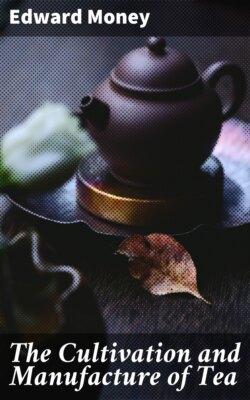Читать книгу The Cultivation and Manufacture of Tea - Edward Money - Страница 15
На сайте Литреса книга снята с продажи.
Kumaon.
ОглавлениеTable of Contents
It was in this district (a charming climate to live in, with magnificent scenery to gaze at) I first planted Tea in India, and I much wish for my own sake, and that of others, I had not done so. I knew nothing of Tea at the time, and I thought a district selected by Government for inaugurating the cultivation must necessarily be a good one. No hill climate can be a good one for Tea; but the inner part of Kumaon, very cold, owing to its elevation, high latitude, and distance from the plains, is a peculiarly bad one. Yet there it was Government made nurseries, distributed seed gratis, recommended the site for Tea (see the “Records” alluded to), and led many on to their ruin by doing so. The intention of the Government was good, but the officers in charge of the enterprise were much to blame, perhaps not for making the mistake at first (no one at the first knew what climate was suitable), but for perpetuating the mistake, when later very little enquiry would have revealed the truth. I believe it was guessed at by Government officials long ago, but it was easier to sing the old tune; and a very expensive song it has proved to many.[10]
I need scarcely, after this, add that I do not approve of Kumaon for Tea. An exhilarating and bracing climate for man is not suited to the Tea plant. The district has one solitary advantage—rich soil. I have never seen richer, more productive land than exists in some of the Kumaon oak forests, but even this cannot in the case of Tea counter-balance the climate. Any crop which does not require much heat and moisture will grow to perfection in that soil. Such potatoes as it produces! Were the difficulties of transport not so great, a small fortune might be made by growing them.
Could any part of Kumaon answer for Tea it would be the lower elevations in the outer ranges of the hills, but these are precisely the sites that have not been chosen. Led, as in my own case, partly by the Government example, partly by the wish to be out of sight of the “horrid plains,” and in sight of that glorious panorama the snowy range, planters have chosen the interior of Kumaon. Some wisely (I was not one of them) selected low sites, valleys sheltered from the cold winds; but even their choice has not availed much. The frost in winter lingers longest in the valleys, and though doubtless the yield there is larger, owing to the increased heat in summer, the young plants suffer much in the winter. The outer ranges, owing to the heat radiating from the plains, are comparatively free from frost, but there again the soil is not so rich. Still they would unquestionably be preferable to the interior.
Labour is plentiful in Kumaon and very cheap—Rs. 4 per mensem. Transport is very expensive. It costs not a little to send Tea from the interior over divers ranges of hills to the plains. It has then some days’ journey by cart ere it meets the rail, to which 1,000 miles of carriage on the railroad has to be added.
Since the above was written, Kumaon has secured a good local market, and I believe sells most of its Tea unpacked to merchants who come from over the border to buy it.
It has also improved its position greatly by making Green Teas, for which, as observed before, the China plant is so well fitted. With those two advantages, though the climate is inferior, I suspect that Tea there now pays better than in Darjeeling.
Gurhwall is next to Kumaon, and so similar that I have not thought it necessary to discuss it separately. The climate is the same, the soil as a rule not so good. There is one exception though, a plantation near “Lohba,” the Teas of which (owing, I conceive, to its peculiar soil) command high prices in the London market. The gardens, both in Kumaon and Gurhwall, have been generally much better cared for than those in Eastern Bengal. As a rule they are private properties managed by the owners.
